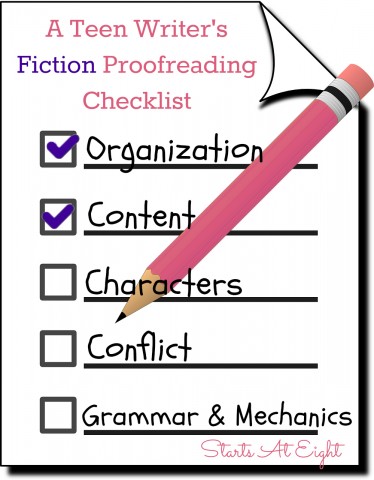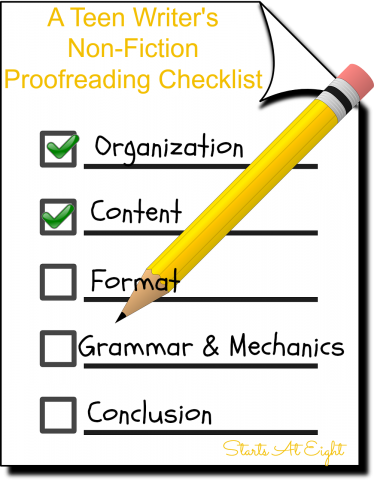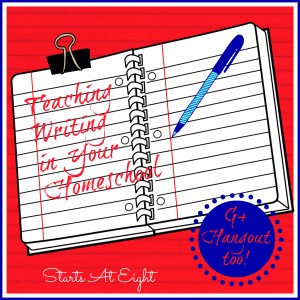A Teen Writer’s Fiction Proofreading Checklist
As my children get older I find it very difficult to grade their writing. The written word can be so subjective. To help not only myself, but my children as well, to be more methodical and critical of their own written works, I created checklists. This is my Fiction Proofreading Checklist.

As I previously wrote in A Teen Writer’s Non-Fiction Proofreading Checklist:
“Judging the written word can be daunting and scary. Are we being to hard? Too easy? Is it a creative difference or a concrete grammar issue? These questions can be answered in so many ways and each person might answer them differently. It is important not to pick too much as you might squelch your child’s creativity in the process.”
While some aspects of writing are so subjective, there are some very basic things to keep in mind when evaluating writing.
Quick Fiction Proofreading Tips:
- All papers should cover the topic of the assignment without going off on a tangent, or seeming to lack in information and content.
- All papers should have solid grammar and mechanics. Things like spelling, capitalization and punctuation are all important things to look for.
- Fiction papers need to have clear, solid character development.
- Including a conflict is central to a fiction paper (The conflict concerns a problem with the main character. It is the struggle between the opposing forces on which the action in a work of literature depends.)
- Your conflict needs to reach a climax (The climax is the turning point of the story; The moment when the suspense reaches its peak; The climax is the problem of the story.)
- The conflict also needs to have a resolution (The resolution is the part in the story where the nail biting plot, mystery, or situation in the book is finally solved and the climax of the story is brought to an ending. The act of finding an answer or solution to a conflict, problem.)
I created both this Fiction Proofreading Checklist as well as a Non-Fiction Proofreading Checklist as a way for my teen to take a step back and go through her work again before presenting it to me. I will then use the same checklist and go through her work. This offers us both the chance to look over the mechanics and major points needed. Then we take the time to discuss any sentences that don’t seem to flow well, or other major points that are more subjective to the work. Ultimately, I give her creative license and allow her to have those decisions go the way she is most comfortable.
Download a printable pdf version of my Fiction Proofreading Checklist
If you haven’t read my tips for assessing non-fiction writing you can check them out at A Teen Writer’s Non-Fiction Proofreading Checklist and download the pdf for that checklist.






